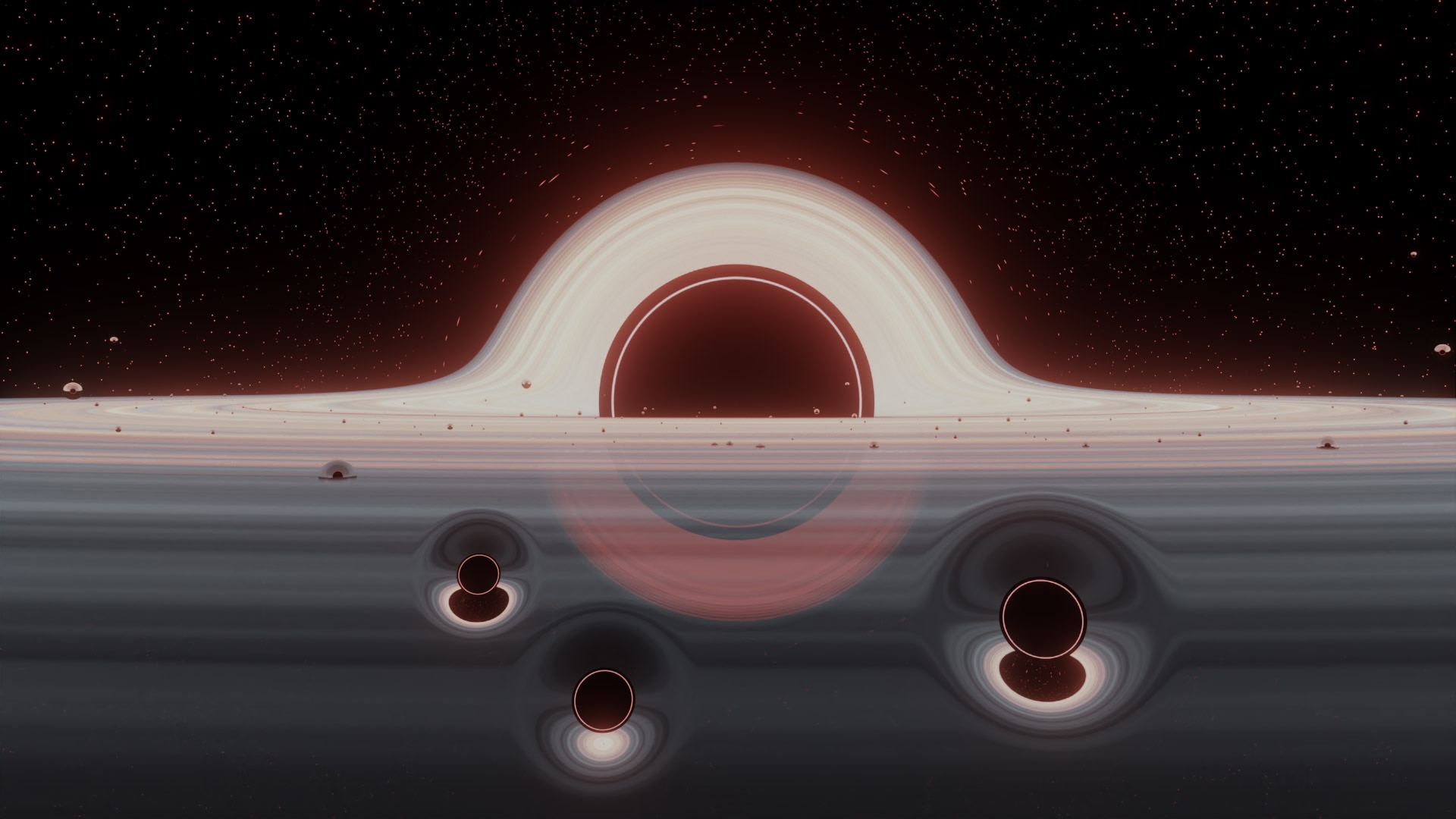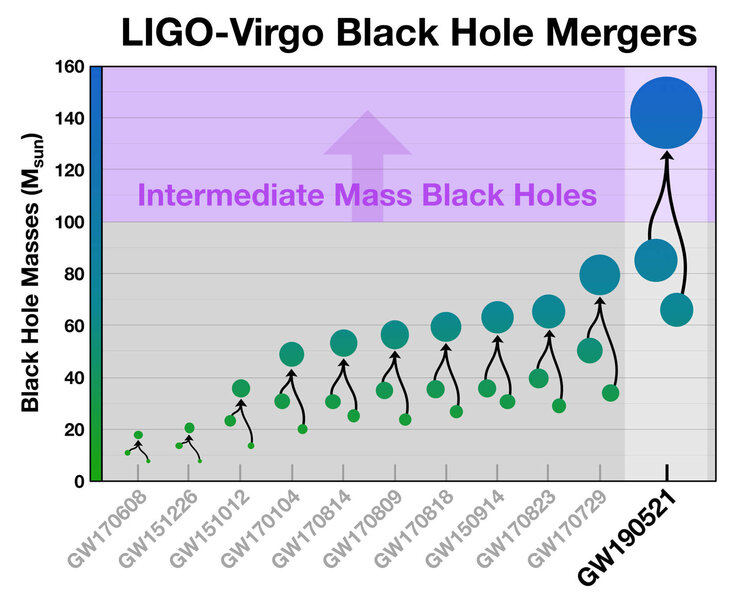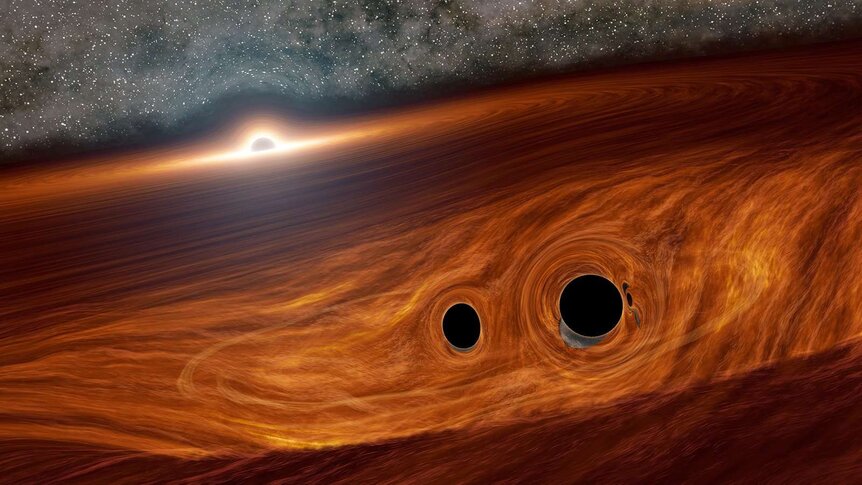Create a free profile to get unlimited access to exclusive videos, sweepstakes, and more!
Explaining off-kilter black hole mergers may need a lot more black holes. A lot.
I heard you like black holes so I put black holes in your black holes with other black holes.

In 2019, ripples in the fabric of spacetime swept over Earth, the gravitational wave announcement of two black holes merging. But unlike the dozens of such mergers seen previously, this one was pretty weird. For one thing, the two component black holes were really massive — many dozens of times the mass of the Sun — but the signal received indicated other odd characteristics. One idea to explain this is that the two were whirling around each other on highly elliptical orbits before they collided, but that's weird too: The immense gravitational forces should have circularized the orbits in short order.
So how do we explain the peculiar nature of this event? Some scientists have an idea: The two black holes weren't alone. They themselves were in the enormous disk of material surrounding a much, much larger black hole, and were surrounded by many, many other such black holes, too.
A huge black hole in a vast swarm of smaller black holes is an incredibly cool if terrifying idea. But it might just explain what happened.
The event is called GW190521, and it was detected by the LIGO/Virgo collaboration on May 21, 2019 — hence its name. The gravitational waves emitted by the collision of two black holes are ripples in spacetime, like waves moving through a sheet when you flap it. Encoded in those waves is a lot of info about the black holes themselves: Their masses, the shape of their orbits, their spin, and more. Scientists create models of black holes mergers and then try to match the simulated events to ones actually seen, and then figure out what's what with the black holes from there.
GW190521 is best fit by two black holes with at least 60 times the Sun's mass, which is huge. Most black holes should have less than half that much mass. Also, the best fit to their orbits indicate their mutual dance was highly elongated, which, if they were isolated in space, is nearly impossible.
One clue, which is tentative but interesting, is that the Zwicky Transient Facility observed a flash of light in the sky that could have been due to the merger. Black hole mergers are usually dark, emitting no light, but that depends on environment.
In the very center of every big galaxy there's a supermassive black hole with millions or billions of times the Sun's mass, and many are surrounded by a huge disk of material many light years wide that feeds the black hole. Smaller black holes, created when stars explode, can fall into this disk (or the stars themselves may be born there), and in fact there could be a lot of them in a typical supermassive black hole disk.
This profoundly changes what can happen. For one thing, the black holes can grow by eating the material around them growing more massive. Also, with so many black holes in the disk collisions are more frequent, again allowing the black holes to grow.
More importantly, though, is that two black holes that approach each other in that disk can fall into orbit around one another. That's very hard to do in the empty space between stars, but the material in the disk can absorb some of the energy of motion of the two black holes, allowing them to become a binary system.
Not only that, but if the pair approach another single black hole, the gravity of the third can give a big kick to the pair, elongating their orbits — what we call enhancing their eccentricity — changing their paths from circular to elliptical. If they get close enough together they can merge — creating a gravitational wave event like the one seen from GW190521; two more-massive-than-usual beasts colliding on an elliptical orbit.
To test this idea, a team of scientists simulated what would happen if a lot of stellar-mass black holes were embedded in the huge disk of a supermassive black hole [link to paper]. What they found is that is that this scenario really does work, and works well. The odds of an eccentric collision go up by a factor of one hundred, which is pretty impressive.
There's also the issue of spin. Black holes spin — they form from the collapsing cores of stars, and as the core shrinks its spin increases due to conservation of angular momentum, the same thing that causes ice skaters to spin more rapidly when they draw their arms in. In some black hole mergers, the axis of spin of the two individual black holes point in the same direction, and are 90° from the plane of their orbit; think of it as the black holes' equators spinning in the same plane as their orbit. But in GW190521 the black hole spin axes were apparently tipped way over compared to their orbits.
That could be due to encountering a third black hole as well. The intruder would yank pretty hard on the binary orbit, tipping it while keeping the two black holes still spinning in the same direction.
I want to be clear and say that this may very well explain GW190521, but being consistent with observations isn't proof. There may be more physics going on here we don't know yet. But it's very interesting indeed that the simulations can reproduce so many characteristics of the event.
Another fascinating aspect of all this is that having binary black holes in the disk around a supermassive one is so efficient at making them merge that this may be the avenue the Universe uses to make most of the mergers we see! On their own, a binary black hole can take billions of years to merge, but in a disk that can be sped up considerably. So it may actually be very common.
That was really surprising to me when I first learned it! And it makes me think that, of all the weird things black holes can do, pulling even more weird stuff out of a hat is maybe the least surprising thing they do.





























